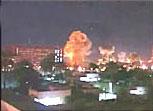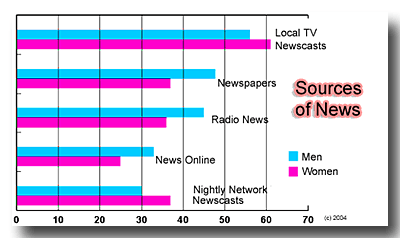|
Film, Radio and TV - 35 |
Updated: 05/15/2005 |
|
We can more fully appreciate the power and influence of TV news when we consider the lengths to which some people and nations go to control it. As we have seen countless times, the news media is the first target for those who want to control the people of a country. Although censorship is often justified as a way of protecting
Today, there are many countries that censor broadcast news and the Internet. Although the stated justification may be to protect moral values, the list of censored materials sometimes includes the web pages of The New York Times, the Washington Post and The Los Angeles Times. Even with its First Amendment to the Constitution guaranteeing free speech, the United States, has had a long history of censorship attempts--many successful. Today, Internet censorship is the latest frontier for those who fear the impact of certain words and pictures. Although broadcast news has had There is no doubt that most news in the United States --especially at the network level--is ratings-driven. Thus, stories that will grab and hold an audience are often favored over those which, in the long run, may be much more consequential. Stories that are "visual" are favored over those that are static and more difficult to explain. A baby beauty contest or a dog show may win out over coverage of a city council meeting or a international trade conference. Given the preferences of viewers who are constantly "voting" on program popularity with their TV remote controls, a news director, whose job largely depends on maximizing ratings and station profits, may have little choice but to appeal to popular tastes.
Those involved in broadcast news must understand 12 factors that constitute news value, or newsworthiness.
1. Timeliness:
News is what's new. An afternoon raid on a rock cocaine house may warrant
a live ENG report during the 6 p.m. news. However, tomorrow, unless there are major
new developments, the same story will probably not be important enough to mention.
2. Proximity: If 15 people are killed in your hometown, your local TV station will undoubtedly consider it news. But if 15 people are killed in Manzanillo, Montserrat, Moyobambaor, or some other distant place you've never heard of, it will probably pass without notice. But there are exceptions. 3. Exceptional
quality: One exception centers on how the people
died. If the people in Exceptional quality refers to how uncommon an event is. A man getting a job as a music conductor is not news--unless that man is blind. 4. Possible future impact: The killer bee example illustrates another news element: possible future impact. The fact that the killer bees are now in the United States and may eventually be a threat to people watching the news or to their relatives living in another state, makes the story much more newsworthy. A mundane burglary of an office in the Watergate Hotel in Washington, DC, was hardly news until two reporters named Woodward and Bernstein saw the implications and the possible future impact. Eventually, the story behind this seemingly common burglary brought down a presidency. 5. Prominence: The 15 deaths in Manzanillo might also go by unnoticed by the local media unless someone prominent was on the bus--possibly a movie star or a well-known politician. If a U.S. Supreme Court Justice gets married, it's news; if John Smith, your next-door neighbor, gets married, it probably isn't. 6. Conflict:
Conflict in its many forms has long held the interest of observers. The conflict could be as simple as a person standing on his principles and spending a year "fighting city hall" over a parking citation. In addition to "people against people" conflict, there can be conflict with wild animals, nature, the environment, or even the frontier of space. 7. The number of people involved or affected: The more people involved in a news event, be it a demonstration or a tragic accident, the more newsworthy the story is. Likewise, the number of people affected by the event, whether it's a new health threat or a new tax ruling, the more newsworthy the story is. 8. Consequence: The fact that a car hit a utility pole isn't news, unless, as a consequence, power is lost throughout a city for several hours. The fact that a computer virus found its way into a computer system might not be news until it bankrupts a business, shuts down a telephone system, or endangers lives by destroying crucial medical data at a hospital. 9. Human
interest: Human-interest stories are generally On a slow news day even a story of fire fighters getting a cat out of a tree might make a suitable story. (Or, as shown here, a kid meeting a kid.) Human-interest angles can be found in most hard news stories. A flood will undoubtedly have many human-interest angles: a lost child reunited with its parents after two days, a boy who lost his dog, or families returning to their mud-filled homes. 10. Pathos: The fact that people like to hear about the misfortunes of others can't be denied. Seeing or hearing about such things commonly elicits feelings of pity, sorrow, sympathy, and compassion. Some would call such stories "tear jerkers." Examples are the child who is now all alone after his parents were killed in a car accident, the elderly woman who just lost her life savings to a con artist, or the blind man whose seeing-eye dog was poisoned. This category isn't just limited to people. How about horses that were found neglected and starving, or the dog that sits at the curb expectantly waiting for its master to return from work each day, even though the man was killed in an accident weeks ago. 11. Shock value: An explosion in a factory has less shock value if it was caused by gas leak than if it was caused by a terrorist. The story of a six year-old boy who shot his mother with a revolver found in a bedside drawer has more shock (and therefore news) value than if same woman died of a heart attack. Both shock value and the titillation factor (below) are well known to the tabloid press. The lure of these two factors is also related to some stories getting inordinate attention, such as the sordid details of a politician's or evangelist's affair--which brings us to the final point. 12. Titillation component: This factor primarily involves sex and is commonly featured--some would say exploited--during rating periods. This category includes everything from the new fashions in men and women's swim wear to an in-depth series on legal prostitution in the state of Nevada. (Click on "more" for the second half of this section.)
|


 The
various Internet providers, such as Earthlink, AOL, and Yahoo reported a five- to
tenfold increase in streaming video and audio through their sites.
The
various Internet providers, such as Earthlink, AOL, and Yahoo reported a five- to
tenfold increase in streaming video and audio through their sites. lumped
together TV news (local plus network) comprise the most popular source of
news in the United States.
lumped
together TV news (local plus network) comprise the most popular source of
news in the United States.
 Manzanillo were killed because of a bus or car accident, this would not be nearly
as newsworthy as if they died from an earthquake or stings from "killer bees," feared
insects that have now invaded the United States.
Manzanillo were killed because of a bus or car accident, this would not be nearly
as newsworthy as if they died from an earthquake or stings from "killer bees," feared
insects that have now invaded the United States. It can be open, overt conflict, such as a civil uprising against police authority,
or it may be ideological conflict between political candidates.
It can be open, overt conflict, such as a civil uprising against police authority,
or it may be ideological conflict between political candidates. soft news. Examples would be a baby beauty contest, a person whose pet happens to
be a nine-foot boa constrictor, or a man who makes a cart so that his two-legged
dog can move around again.
soft news. Examples would be a baby beauty contest, a person whose pet happens to
be a nine-foot boa constrictor, or a man who makes a cart so that his two-legged
dog can move around again.